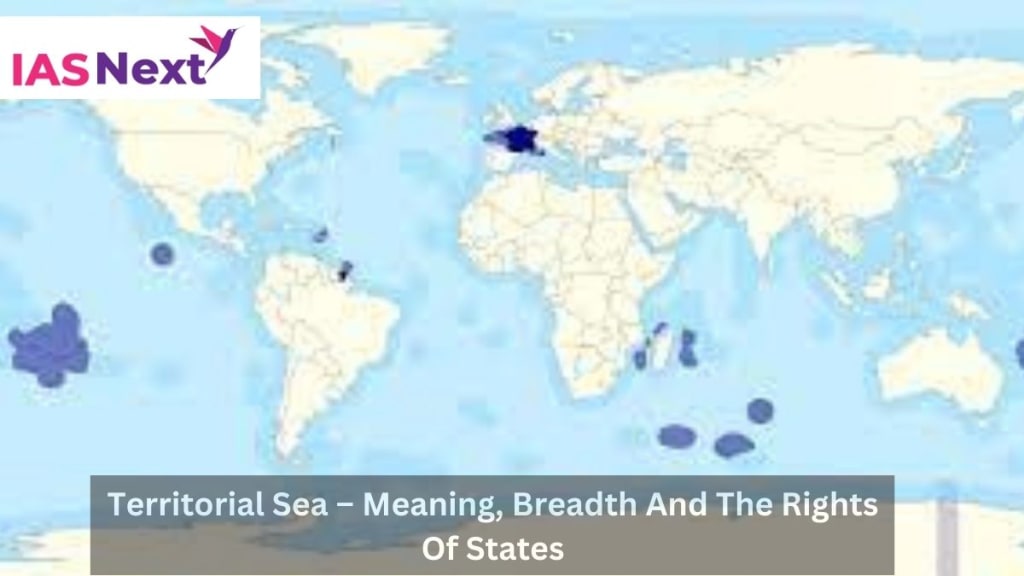Territorial Sea – Meaning, Breadth And The Rights Of States
IAS NEXT is a topmost Coaching Institute offering guidance for Civil & Judicial services like UPSC, State PCS, PCS-J exams since more than 10 years.

Introduction:
Territorial sea is that part of the sea which is adjacent to the coastal State and which is bounded by the high seas on its outer edge. The Coastal State exercises its sovereignty over this area as it exercises over its internal waters. The sovereignty extends to the airspace over the territorial sea as well as its bed and sub-soil. This sovereignty accrues to a State under the customary international law which no State can refuse.
However, the sovereignty over this area has to be exercised subject to the provisions of the conventions and ‘to other rules of international law’, which provides certain rights to other States, particularly right of ‘innocent passage’ in the territorial waters of the State.
Breadth of the Territorial Sea: The breadth of the territorial sea has remained a thorny issue, and up to 18th century the opinion was, that breadth of territorial sea extends to the range of a cannon-shot which at that time was three nautical miles. The three-mile rule, popularly known as ‘cannon-shot’ rule as propounded by the Dutch jurist Bynkershock, had a rationale that a State’s sovereignty extended to the sea as far as a canon or fire could reach. Before the 1982 Sea Convention was concluded, States proclaimed varying breadth of the territorial sea, generally ranging from 3 to 12 miles, though in certain cases they had proclaimed wider areas than that, in few cases up to 200 nautical miles. But at the UNCLOS-III, claims wider than 12 miles did not find favour and the 12 miles rule was accepted by the Conference, which may be considered the present customary international law position.
Article 3 of the 1982 Sea Convention limits the breadth of the territorial sea to 12 nautical miles ‘measured from baselines determined in accordance with the Convention’. Two methods have been laid down for measuring the breadth of the territorial sea: the low-water line and the straight baseline. The normal method used is the low-water line as marked on large-scale charts officially recognized by coastal State. Where the coastline is deeply intended and cut into, or if there is a fringe of islands along the coast in its immediate vicinity, the straight baseline method joining appropriate points may be employed in drawing the baseline from which the breadth of the territorial sea is measured.
The method of straight baseline was enunciated by the Anglo Norwegian Fisheries case, which had a decisive effect on the baseline issue. In this case, Norway which has a fringe coastline, by its 1935 Decree proclaimed exclusive fishery zone (meant territorial sea) along almost 1000 miles of its coastline. The zone which was four miles wide, measured not from the low-water mark but from straight baselines linking some 48 outer most points of island and lands, at a considerable distance from the coast By using the straight baselines, some of which was 30 miles long and the longest was 44 miles, Norway could enclose waters within its territorial sea that would have been the high seas, and hence open to foreign fishing.
The UK, whose fishing interests were affected by this Decree, challenged the legality of the straight baseline system adopted by Norway and the choice of certain baselines used in applying it. The Court upheld the method applied by Norway in drawing the baselines and it also did not reject the criterion of low water mark. But the manner of application of straight baselines is ‘dictated by geographical realities’.
It was propounded by the judgment that where a State has a rugged coastline, deeply indented, or if there is a fringe of islands in the immediate vicinity, the straight baseline, joining the low water at appropriate points, is admissible....Read more
Read Also : Law Of The Sea – History, Evolution And Provisions
About the Creator
Enjoyed the story? Support the Creator.
Subscribe for free to receive all their stories in your feed. You could also pledge your support or give them a one-off tip, letting them know you appreciate their work.





Comments
There are no comments for this story
Be the first to respond and start the conversation.